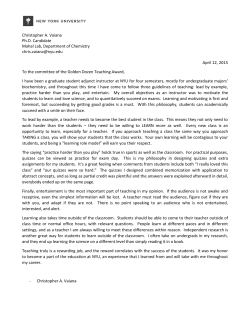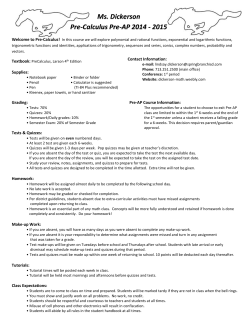
ppt
Physics 326: Computer Based Experimentation and Physics Computing Instructor: Office: Phone: e-mail Office Hour: Prof. Weida Wu Serin W 117 848-445-8751 wdwu@physics.rutgers.edu By appointment TA: Wenhan Zhang (wenhan@physics.rutgers.edu) Textbook: “An Introduction to Error Analysis”, J.R. Taylor, 2nd Ed. University Science Books. Web Site for Course: http://www.physics.rutgers.edu/ugrad/326/ Lecture and Lab sections Lecture (Wu): Wednesday (8:10-9:30PM) SEC 209 Lab Sect. 3 (Zhang): Monday (6:40pm-9:30pm) Serin 101 Lab Sect. 1 (Wu): Serin 101 Tuesday (10:20am-1:20pm) Lab Sect. 2 (Zhang): Tuesday (3:20pm-6:20pm) Serin 101 Lab Sect. 4 (Zhang): Thursday (6:40pm-9:30pm) Serin 101 No more than 2 people per group. Finish data collection and/or analysis during lab session. Preparation for the labs Lab instructions are posted to the course web site. You are expected to download, print, and read these instructions before coming to lecture. Each lab will be discussed in the Wednesday lectures before the lab. In addition, you should understand what to do in the lab BEFORE coming to a lab. Reports and quizzes Lab Reports: Lab reports are to be prepared individually and handed in during the lab session of the following week, i.e., you have one week to write your report. No late reports will be accepted. Copied lab reports will not be accepted. Do not write a report if you have not actually done the lab; it will not be accepted. Type and print your reports. No hand written report will be accepted. Quizzes (5-7): Short quizzes will be given occasionally during lectures through the semester. Topics in the quizzes are lecture and lab contents, reading assignments. Make-up quizzes will not be offered unless you have a documented medical reason for missing the quiz. Grading The course grade will be based mostly on the lab reports (~90%), with the remainder determined by quiz scores and lecture attendance. Grade cutoffs (Tentative) A B+ B C+ C D F 90 85 75 70 65 50 <50 Format of lab report • Introduction (a short overview/background) – What is this about? Why is it interesting? • Method – techniques, instruments, procedure, data analysis, error analysis – Do NOT copy from lab manual • Results and discussion – tables and figures – connect the results back to the theory (intro) • Conclusion – one or two sentences • References (if any) Course schedule 9 lectures, 12 labs, 8 reports, 5-7 quizzes Lab 1: Propagation of error Errors, or uncertainties, are inevitable in measurements. Note that here “errors” mean random errors. One should always avoid systematic errors. x Errors: random vs. systematic Statistical Analysis of random error Random error is treated as a random variable that follow a random distribution. Q: How to evaluate random errors? A: Repeated measurements. The mean and the standard deviation x1 x2 The mean: x N xN 1 N N x i 1 i N : # of measurements xi : value of ith measurement The standard deviation (error) of a single measurement: x 1 N 2 xi x N 1 i 1 i.e. x x xi x How about standard deviation of the mean? The standard deviation of the mean The mean: 1 x N N x i 1 i N : # of measurements xi : value of ith measurement Standard deviation of the Mean (error of the average value): x x N x x More discussion of this topic in lab 3. How to report errors properly? Measurement and error: x x Rules of reporting error: 1. (measured value of x) = xbest ± δx x x x x x 2. Experimental uncertainties should almost always Note: x 0 be rounded to one significant figure. 3. The last significant figure in any stated answer should usually be of the same order of magnitude (in the same decimal position) as the uncertainty. An example g = 9.82138 m/s , g =0.02326 m/s 2 2 x x x Rules of reporting error: 1. (measured value of x) = xbest ± δx g = 9.82138 0.02326 m/s 2 x x 2. Experimental uncertainties should almost always be rounded to one significant figure. g = 0.023 g = 0.02 3. The last significant figure in any stated answer should usually be of the same order of magnitude (in the same decimal position) as the uncertainty. g = 9.821 g = 9.82 g = 9.82 0.02 m/s2 One exception of rule #2 If the leading digit in the uncertainty δx is a 1, then keeping two significant figures in δx is more reasonable. E.g. g = 9.82168 m/s , g =0.01326 m/s 2 g =0.013 m/s2 g = 9.822 m/s2 g = 9.822 0.013 m/s 2 2 Exercises: how to report errors The propagation of errors (one variable) If q is a function of one independent variable x, q q x Then For example: dq q x dx q ax q a x q ax b q a x qx n q q n x x The propagation of errors (multivariable) Provisional rules: (for quick estimation) q q x, y q q q x y x y Examples: q x y, or q x y q x y, q x / y q x y q q More precisely: x y x q q q x y x y y Propagation of independent errors If the uncertainties x, y are independent of each other, q q y y q x x q q q x y x y 2 2 This can be generalized to multivariable functions: q x1 , x2 , 2 2 q q , xN x1 x2 x1 x2 q xN xN 2 Lab 1: Torsion Pendulum k d 2 k I 2 I dt d k 2 I , T 2 I k L m 2 2 I a b Moment of inertia: 12 Torque constant: k d 4M 32 L M: Modulus of rigidity m b a Torsion Pendulum 2 4 2 4 2 m 2 m 2 2 2 k 2 I 2 a b a b 2 T T 12 3T 32 L 32 L 2m 2 2 M k a b 4 4 2 d d 3T Modulus of rigidity: (a.k.a. modulus of torsion, the shear modulus of elasticity) 2 2 Lm a b 32 M 3 d 4T 2 Quantities to measure L: length of the steel wire d: diameter of the steel wire m: mass of the rectangular block a: width of the rectangular block b: length of the rectangular block T: period of torsional oscillation
© Copyright 2025

















